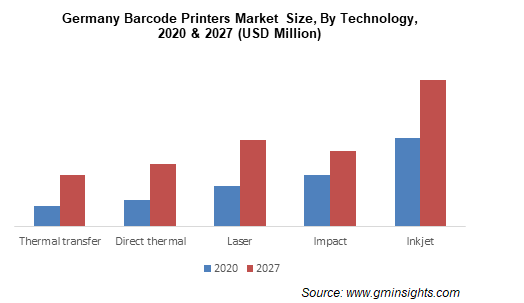Home > Professional Services > Barcode Printers Market
Barcode Printers Market Analysis
- Report ID: GMI147
- Published Date: Nov 2021
- Report Format: PDF
Barcode Printers Market Analysis
The U.S. industrial barcode printers market is expected to showcase 5% growth rate through 2027 led by the increased use in harsh environments for mission-critical operations. The industrial barcode printers available in the market have rugged durability and offer robust performance with a user-friendly platform. These barcode printers are made of durable steel structural components that can withstand severe temperatures, debris, dust, and other harsh industrial conditions. They have meticulously engineered printing mechanisms to offer high volume noise-reduced printing. Market players including TSC Auto ID Technology Co., Ltd. and Zebra Technologies Corporation offer industrial printers with enhanced features including LCD displays, multiple resolutions, and extensive communication options including Wi-Fi and Bluetooth.
In Germany, thermal transfer technology is estimated to attain a CAGR of 14% CAGR and will exceed USD 60 million by 2027 on account of the rise in the demand for high-definition text and graphic print quality for maximum readability and scannability. Thermal transfer printing ensures long-term image stability and allows for batch or single label printing with less waste. In comparison to ink jet, dot matrix and laser printing, long-term maintenance expenses are low. Thermal transfer technology will help in overall barcode printers market expansion as it can print on an infinite range of media stocks. Thermal transfer printers are often more durable than dot matrix or laser printers, allowing for efficient operation in both industrial & office applications.
Market leaders offer barcode printers with resolution of above 601 dpi, improving operational efficiency by creating readable characters and scannable barcodes on some of the smallest tags and labels. Barcode printers with print resolutions more than 601 dpi provide high-quality outputs to meet the demands of certain applications, where lower resolution printers cannot meet barcode-label standards.
Such barcode printers are employed in manufacturing applications that need small fonts and tiny barcodes including electronic board labeling and regulatory labels with serial numbers or symbols. High resolution barcode printers are used in medical applications that need small characters and barcodes. Barcode printers with above 601 dpi provide enhanced high-resolution printing capabilities for extremely small labels, including 0.75-inch wide by 0.25-inch tall, with precise font and barcode positioning requirements.
Wireless barcode printers available in the market are used to connect with various devices through advanced technologies including Cloud, Bluetooth, Wi-Fi, Near Field Communication (NFC), and Air Print. The barcode printers work on wireless networks with the latest security protocols to offer improved performance & connectivity. The Wi-Fi modules are designed to work with standard network management tools for simple integration and management of barcode printers on a network. The barcode printers simplify Bluetooth pairing and launch web-based pages with NFC-enabled devices. Wireless printers eliminate the need for on-premises servers by reducing the cost for enterprise-level managed device ecosystems. Using thermal technology, wireless printers can be connected to any device to produce high-quality labels. Wireless printers are cost-effective solutions that can be combined with an mPOS system that offers long battery life.
Barcode printers are used for manufacturing as they reduce product search time and enhance manufacturing process control. Barcoding helps to enhance compliance, improve work-in-process (WIP) productivity, and reduce finished goods costs. It enables real-time monitoring of production, order fulfilment, and distribution processes and their level of efficiency in real-time. Market players offer barcode printers for designing tags that reduce labor costs by eliminating manual steps and improve order & shipping accuracy. Barcode printers are increasingly used in the manufacturing sector as they ensure error-free and timely delivery, thus improving customer satisfaction. They promote real-time data capture through Warehouse Management Systems (WMS) and Enterprise Resource Planning (ERP) systems.

The Asia Pacific barcode printers market captured 17% of the revenue share in 2020. According to India Brand Equity Foundation (IBEF), India’s e-commerce market is predicted to grow to USD 111.40 billion by 2025 from USD 46.2 billion as of 2020. This helps to increase the demand for barcode printers used in e-commerce inventory management. E-commerce warehouses use barcode printers to design tags and labels to optimize available space by relabeling pallets.
To support rising customer demand for faster shipments in warehouses, e-commerce market players use barcode printers to increase efficiency in the ordering, picking, packing, and shipping process. The barcode printers market will expand in APAC as barcode tags enhance efficiency and lower inventory management costs.

